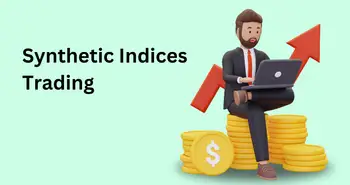The Psychology of the Market Cycle: How Investors React

When the global financial crisis hit in 2008, markets plunged into chaos as fear gripped investors, leading to panic selling. Those who remained calm, however, saw it as an opportunity and positioned themselves for long-term gains. This illustrates a key lesson in investing: understanding market cycles and the psychology behind investor behavior can help us make more informed, rational decisions.
In this article, we’ll explore the phases of market cycles, the psychological factors that influence them, and practical strategies you can use to manage your emotions during volatile times.
Quick Summary
- Market Phases: Understand accumulation, markup, distribution, and markdown phases.
- Emotional Impact: Fear and greed heavily influence market decisions.
- Volatility Strategy: Stay calm and use tools like stop-losses and diversification.
- Predicting Trends: Use technical, fundamental, and sentiment analysis.
- Emotional Control: Build resilience to avoid impulsive trading.
What Are Market Cycles?
Market cycles can be defined as the stages that markets go through, including bull markets, bear markets, and everything in between. Bull markets are characterized by rising prices and a positive investor sentiment, while bear markets are marked by falling prices and a negative investor sentiment. Recognizing where you are in the cycle helps you make smarter decisions, whether it’s buying, holding, or selling your investments.
Key Factors That Define Market Cycles
Several factors influence market cycles, and understanding them helps you anticipate changes and make better decisions. These factors include:
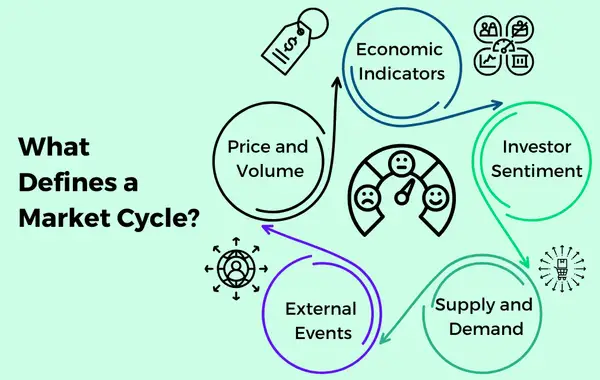
- Economic Indicators: Economic growth (GDP), inflation rates, unemployment, and interest rates help signal where the market is headed. Example: During the 2009 financial crisis, many economic indicators signaled a downturn, marking the start of a bear market. Conversely, the subsequent recovery aligned with improving GDP and unemployment data, initiating the start of a new bull market.
- Investor Sentiment: How optimistic or fearful investors are affects market movement. Confidence drives up prices, while fear drives them down.
- Supply and Demand: Rising demand increases prices, while oversupply or lack of demand pushes prices down. Example: In the accumulation phase, smart money accumulates undervalued assets, often in lower supply. As more investors buy into the market during the markup phase, demand grows, pushing prices higher. At the peak (distribution phase), supply increases as large investors sell off their holdings, eventually causing prices to drop.
- Psychological Phases: The emotions investors experience during a market cycle—hope, fear, greed, and despair—shape the cycle’s momentum.
- Price and Volume: Watching price trends and trading volume gives clues about the strength or weakness of a market phase. Example: Volume spikes during the distribution phase may signal a market top, as large investors exit the market, taking profits while retail investors still buy into the trend.
- External Events: Political events, economic policies, or global crises often disrupt market cycles and create sudden shifts. Example: The COVID-19 pandemic in early 2020 initially caused a rapid markdown phase due to fear and uncertainty. However, aggressive fiscal and monetary policies quickly shifted sentiment, leading to an extraordinary bull market as markets recovered.
The Four Phases of a Market Cycle
1. Accumulation Phase: Buying After a Downturn
In the accumulation phase, astute investors closely monitor the market, searching for undervalued assets with potential for future growth. These investors possess a keen eye for spotting opportunities that others may overlook. They patiently accumulate these assets, taking advantage of the low prices, and positioning themselves for the next phase of the market cycle.
During this phase, it is crucial to conduct thorough research and analysis to identify assets that have strong fundamentals but are currently undervalued. This requires a deep understanding of the market and the ability to identify potential catalysts that could drive the asset's value higher in the future.
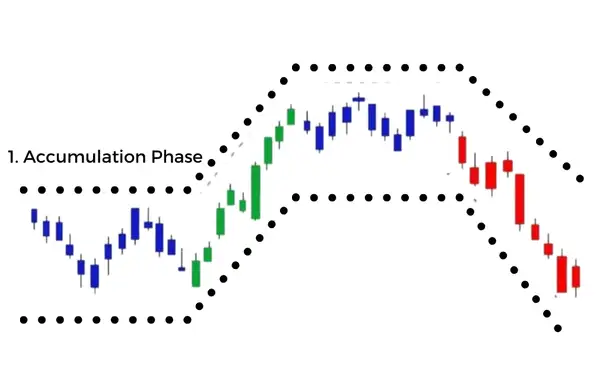
How to Navigate This Phase:
- Research undervalued assets with strong fundamentals.
- Use price-to-earnings ratios or other indicators to spot bargains.
- Be patient—this phase can last for a while before prices start rising.
2. Markup Phase: The Market Gains Momentum
As the market transitions from the accumulation phase to the markup phase, the sentiment shifts, and more investors start recognizing the potential for growth. Prices begin to rise as demand increases, and the market experiences a period of upward momentum.
During this phase, it is essential to closely monitor market trends and investor sentiment. Identifying the catalysts that are driving the price appreciation can help investors make informed decisions. It is also crucial to manage risk effectively by setting appropriate stop-loss orders and regularly reviewing investment portfolios.
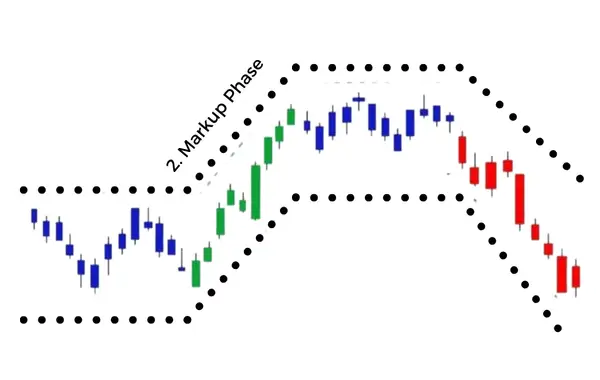
How to Navigate This Phase:
- Watch for increasing trading volume and bullish sentiment.
- Use stop-loss orders to protect against sudden downturns.
- Rebalance your portfolio to ensure it aligns with your risk tolerance.
3. Distribution Phase: The Market Peaks
The distribution phase marks the peak of the market cycle. It is during this phase that smart money investors, who accumulated assets during the earlier phases, start selling their holdings. They take profits and reduce their exposure to the market, anticipating a potential downturn.
During this phase, it is important for investors to exercise caution and avoid getting caught up in the euphoria of a market peak. Implementing risk management strategies, such as diversification and trailing stop-loss orders, can help protect investment portfolios from potential losses.
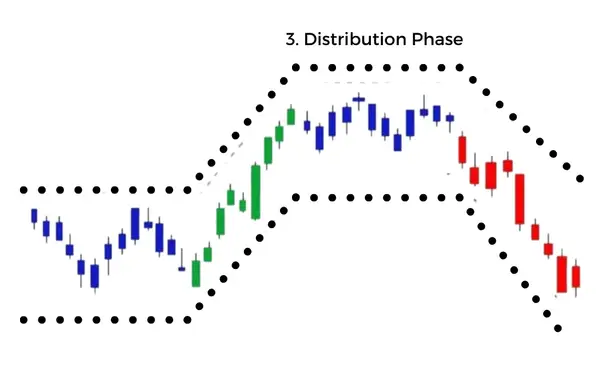
How to Navigate This Phase:
- Take profits strategically—don’t hold on for too long if prices are reaching unsustainable levels.
- Look for warning signs like price volatility or diverging indicators (e.g., RSI or MACD signaling weakness).
- Use trailing stop-losses to protect your gains.
4. Markdown Phase: The Market Declines
The markdown phase is characterized by falling prices and a sense of fear in the market. It is during this phase that the market corrects itself, often due to a combination of profit-taking, economic factors, or unforeseen events. Prices decline as investors sell off their holdings, seeking to preserve capital or take advantage of buying opportunities.
During this phase, it is crucial to stay calm and avoid making impulsive investment decisions based on fear or panic. Maintaining a long-term perspective and focusing on fundamental analysis can help identify assets that may be undervalued and present attractive buying opportunities.
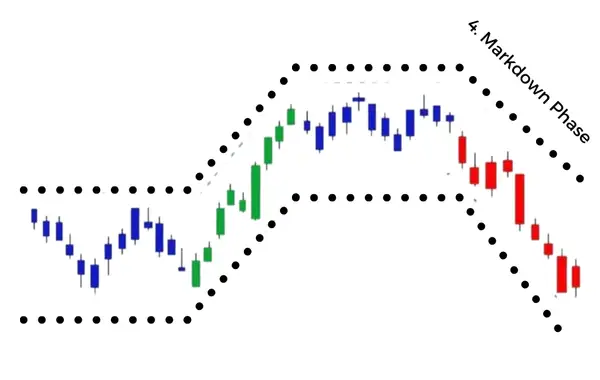
How to Navigate This Phase:
- Avoid selling in a panic. Focus on long-term value rather than reacting emotionally.
- Consider buying back into the market if strong fundamentals remain intact.
- Use technical analysis to identify oversold conditions that may present buying opportunities.
The Role of Psychology in Investing
Psychology plays a critical role in investment decisions. The emotions, biases, and cognitive patterns of investors can heavily influence market cycles. Understanding these psychological factors can help investors manage market volatility and avoid impulsive decisions.
Emotional Investing: Fear and Greed
Fear and greed are the two driving forces behind most investor behavior. During bull markets, greed often takes hold as investors become overconfident and driven by the fear of missing out on potential gains. In bear markets, fear dominates as panic spreads and investors quickly sell off their holdings to avoid further losses.
Fear in Bear Markets: When markets start to decline, fear kicks in, causing investors to sell at low prices in hopes of cutting their losses. This emotional response often leads to missing out on future gains during the recovery phase.
Greed in Bull Markets: In contrast, during bull markets, greed encourages investors to buy more at high prices, hoping for even higher returns. This can result in buying at the top of the market, leading to significant losses when the market corrects itself.
Cognitive Biases in Investment Decisions
In addition to emotions, cognitive biases—our mental shortcuts—can cloud our judgment and lead to poor investment choices. Some of the most common biases include:
Confirmation Bias: Investors tend to focus on information that supports their existing beliefs while ignoring contradictory evidence. This can prevent them from making objective, data-driven decisions.
Herd Mentality: Investors often follow the crowd, buying or selling simply because everyone else is doing it, without conducting their own analysis.
The Intersection of Market Cycles and Investor Psychology
Market cycles and investor psychology are deeply interconnected. How investors feel and behave often determines the direction of market movements, and market shifts, in turn, influence investor sentiment.
How Investor Sentiment Shapes Market Cycles
Investor sentiment—the overall attitude of market participants—can have a profound impact on market cycles. Bull markets are driven by positive sentiment, where optimism and confidence fuel rising prices. Conversely, bear markets are fueled by negative sentiment, where fear and uncertainty drive prices downward.
Example: During the dot-com bubble, investor euphoria caused stock prices to skyrocket. When the bubble burst, fear quickly took over, leading to a market crash as investors fled to protect their capital.
The Psychological Triggers of Market Shifts
Market shifts are often triggered by psychological factors. A sudden change in investor sentiment—driven by a major news event or an unexpected economic downturn—can cause a shift from a bull to a bear market. Predicting these psychological shifts is challenging, which is why timing the market is notoriously difficult.
Example: The COVID-19 pandemic in early 2020 triggered a rapid market markdown phase, with investors reacting to the uncertainty surrounding the global economy. However, aggressive fiscal and monetary policies quickly turned sentiment around, leading to an unprecedented recovery.
Strategies for Managing Psychological Impacts
Successfully navigating market cycles requires more than just technical or fundamental knowledge. Investors must also learn how to manage the psychological impacts of market volatility.
Developing Emotional Resilience
Emotional resilience is the ability to stay calm and rational during periods of market turbulence. Investors who can manage their emotions are less likely to make impulsive decisions based on fear or greed.
How to Build Emotional Resilience:
- Maintain a Long-Term Perspective: Avoid getting caught up in short-term market movements. Focus on your long-term investment goals.
- Have a Plan: Develop a clear investment strategy and stick to it, even when the market is volatile.
- Automate Your Strategy: Use tools like stop-loss orders to take emotion out of decision-making.
Overcoming Cognitive Biases
Overcoming cognitive biases requires self-awareness and active efforts to challenge your assumptions. By recognizing when biases are affecting your decisions, you can make more objective choices.
How to Overcome Biases:
- Diversify Your Portfolio: By spreading your investments across different asset classes, you reduce the impact of emotional decisions in any one area.
- Seek Alternative Viewpoints: Regularly expose yourself to differing opinions and market analyses to counter confirmation bias.
- Document Your Decisions: Keeping a trading journal can help you identify patterns in your decision-making process, allowing you to spot biases before they take hold.
Predicting Market Cycles: Can It Be Done?
Predicting market cycles with absolute accuracy is nearly impossible. However, investors can use a combination of technical analysis, fundamental analysis, and sentiment analysis to make more educated guesses about future trends.
Tools for Predicting Market Cycles:
- Technical Analysis: Tools like moving averages, RSI, and MACD help identify overbought or oversold conditions in the market.
- Fundamental Analysis: Analyzing economic indicators, earnings reports, and market fundamentals can provide insight into the health of the market.
- Sentiment Analysis: Tracking investor sentiment through surveys, the Fear & Greed Index, and social media sentiment can provide clues about potential market shifts.
Tap into Morpher AI for Real-Time Insights
Getting a read on the market can feel like navigating through fog, especially when emotions run high. That’s where Morpher AI comes in. It gives you up-to-the-minute insights, breaking down the data that matters most—whether it’s sentiment shifts or real-time market trends—so you’re not making decisions in the dark. With Morpher AI, you don’t have to get caught up in the noise or guess what’s driving the market. Try yourself now!
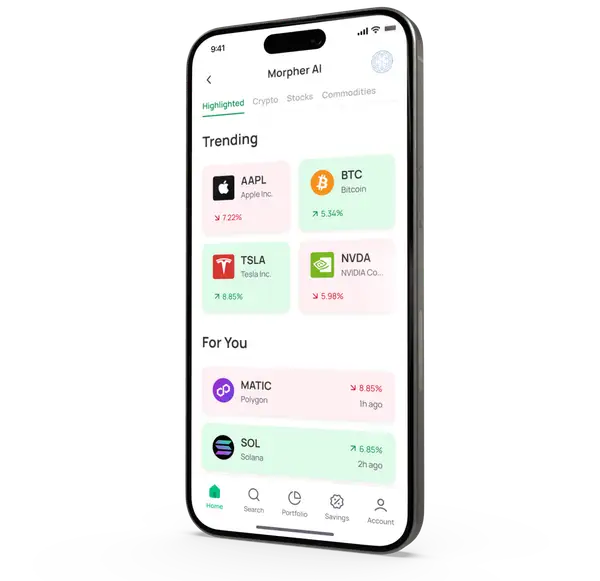
FAQ
What are market cycles?
Market cycles are recurring patterns that occur in the financial markets, characterized by periods of expansion and contraction. They have a significant impact on asset prices.
How does psychology influence investing?
Psychology plays a crucial role in investment decisions. Emotions, biases, and cognitive processes can greatly influence investor behavior and market cycles.
What are some common cognitive biases in investing?
Common cognitive biases in investing include confirmation bias, herd mentality, and overconfidence. These biases can cloud judgment and lead to irrational investment decisions.
How can I manage the psychological impacts of market cycles?
To manage the psychological impacts of market cycles, it is crucial to develop emotional resilience and overcome cognitive biases. This involves understanding and managing our emotions, maintaining a long-term perspective, and seeking alternative viewpoints.
Is it possible to predict market cycles?
Predicting market cycles with absolute certainty is challenging. However, various tools and indicators, such as technical analysis and sentiment analysis, can help us make educated guesses about future market trends.
What is behavioral finance?
Behavioral finance combines psychology and finance to provide a more comprehensive understanding of investor behavior and market cycles. It integrates the principles of cognitive psychology into financial analysis.
As you navigate the complexities of market cycles and investor psychology, consider the advantages of trading on a platform that's designed with the modern investor in mind. Morpher.com offers a revolutionary approach to investing, allowing you to trade across a multitude of asset classes with zero fees, infinite liquidity, and the safety of a non-custodial wallet. Whether you're looking to invest fractionally, short sell without interest fees, or leverage your trades up to 10x, Morpher empowers you to maximize your investment strategy. Embrace the future of trading with Morpher's unique blockchain-based platform. Sign Up and Get Your Free Sign Up Bonus today to start trading smarter.

Disclaimer: All investments involve risk, and the past performance of a security, industry, sector, market, financial product, trading strategy, or individual’s trading does not guarantee future results or returns. Investors are fully responsible for any investment decisions they make. Such decisions should be based solely on an evaluation of their financial circumstances, investment objectives, risk tolerance, and liquidity needs. This post does not constitute investment advice.

Painless trading for everyone
Hundreds of markets all in one place - Apple, Bitcoin, Gold, Watches, NFTs, Sneakers and so much more.

Painless trading for everyone
Hundreds of markets all in one place - Apple, Bitcoin, Gold, Watches, NFTs, Sneakers and so much more.








